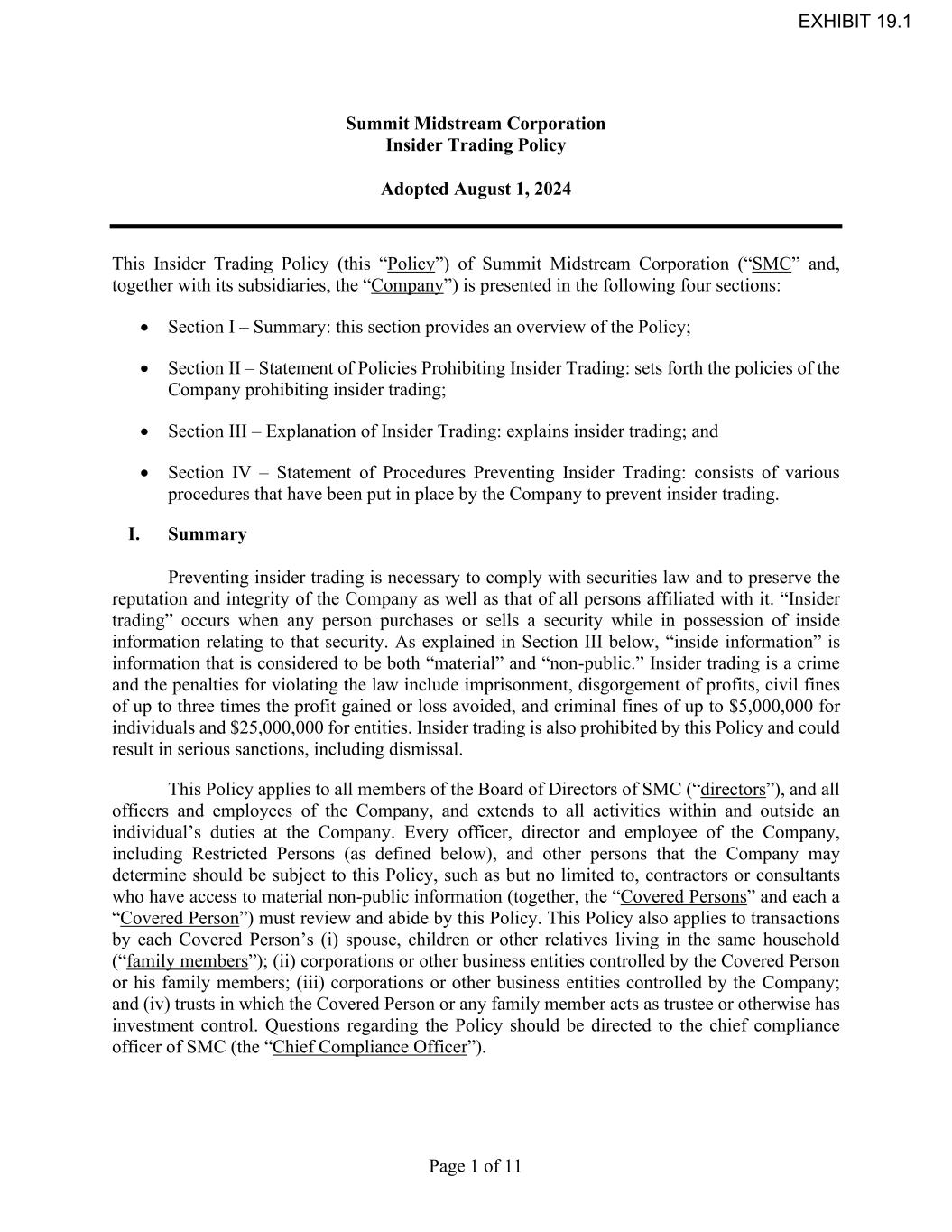
Page 1 of 11 Summit Midstream Corporation Insider Trading Policy Adopted August 1, 2024 This Insider Trading Policy (this “Policy”) of Summit Midstream Corporation (“SMC” and, together with its subsidiaries, the “Company”) is presented in the following four sections: • Section I – Summary: this section provides an overview of the Policy; • Section II – Statement of Policies Prohibiting Insider Trading: sets forth the policies of the Company prohibiting insider trading; • Section III – Explanation of Insider Trading: explains insider trading; and • Section IV – Statement of Procedures Preventing Insider Trading: consists of various procedures that have been put in place by the Company to prevent insider trading. I. Summary Preventing insider trading is necessary to comply with securities law and to preserve the reputation and integrity of the Company as well as that of all persons affiliated with it. “Insider trading” occurs when any person purchases or sells a security while in possession of inside information relating to that security. As explained in Section III below, “inside information” is information that is considered to be both “material” and “non-public.” Insider trading is a crime and the penalties for violating the law include imprisonment, disgorgement of profits, civil fines of up to three times the profit gained or loss avoided, and criminal fines of up to $5,000,000 for individuals and $25,000,000 for entities. Insider trading is also prohibited by this Policy and could result in serious sanctions, including dismissal. This Policy applies to all members of the Board of Directors of SMC (“directors”), and all officers and employees of the Company, and extends to all activities within and outside an individual’s duties at the Company. Every officer, director and employee of the Company, including Restricted Persons (as defined below), and other persons that the Company may determine should be subject to this Policy, such as but no limited to, contractors or consultants who have access to material non-public information (together, the “Covered Persons” and each a “Covered Person”) must review and abide by this Policy. This Policy also applies to transactions by each Covered Person’s (i) spouse, children or other relatives living in the same household (“family members”); (ii) corporations or other business entities controlled by the Covered Person or his family members; (iii) corporations or other business entities controlled by the Company; and (iv) trusts in which the Covered Person or any family member acts as trustee or otherwise has investment control. Questions regarding the Policy should be directed to the chief compliance officer of SMC (the “Chief Compliance Officer”). EXHIBIT 19.1
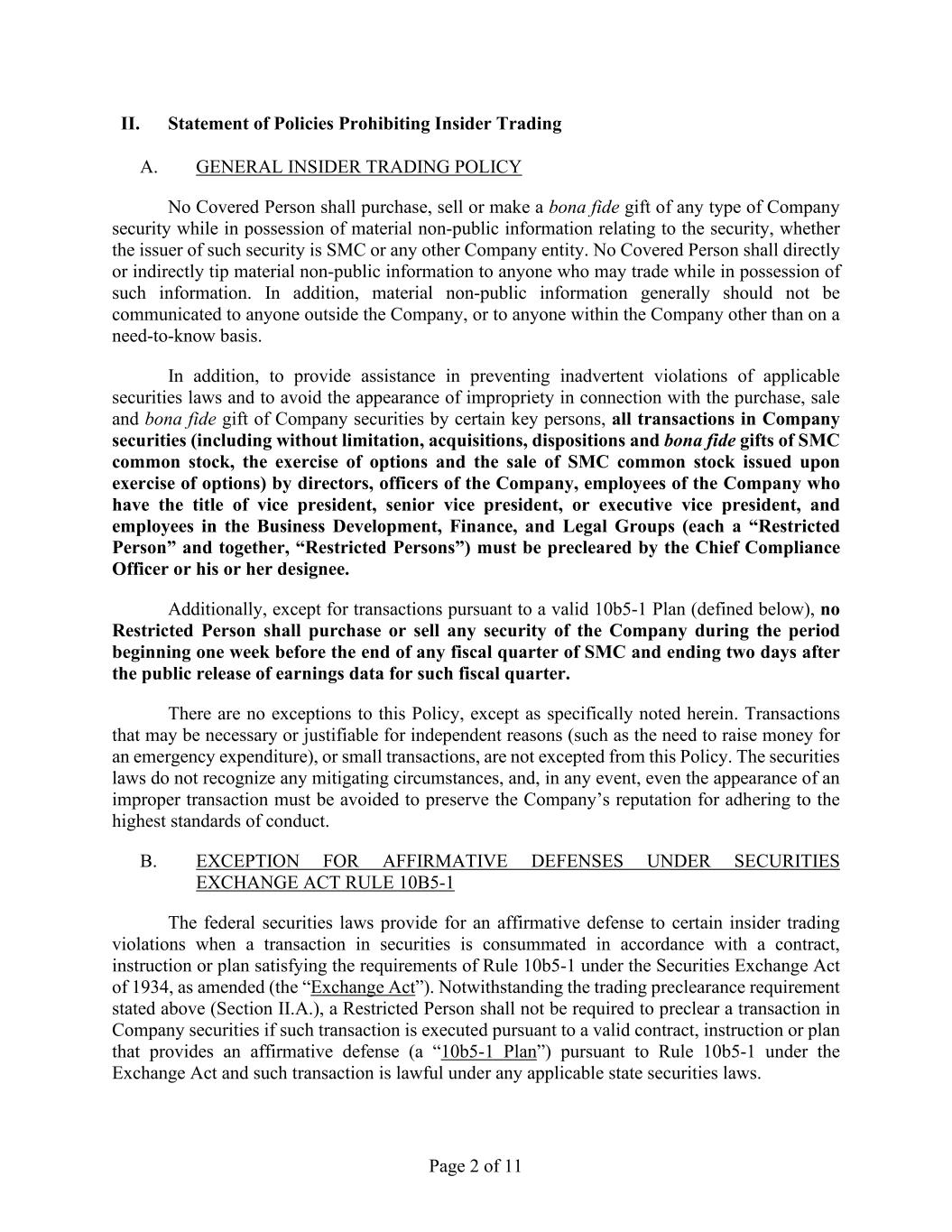
Page 2 of 11 II. Statement of Policies Prohibiting Insider Trading A. GENERAL INSIDER TRADING POLICY No Covered Person shall purchase, sell or make a bona fide gift of any type of Company security while in possession of material non-public information relating to the security, whether the issuer of such security is SMC or any other Company entity. No Covered Person shall directly or indirectly tip material non-public information to anyone who may trade while in possession of such information. In addition, material non-public information generally should not be communicated to anyone outside the Company, or to anyone within the Company other than on a need-to-know basis. In addition, to provide assistance in preventing inadvertent violations of applicable securities laws and to avoid the appearance of impropriety in connection with the purchase, sale and bona fide gift of Company securities by certain key persons, all transactions in Company securities (including without limitation, acquisitions, dispositions and bona fide gifts of SMC common stock, the exercise of options and the sale of SMC common stock issued upon exercise of options) by directors, officers of the Company, employees of the Company who have the title of vice president, senior vice president, or executive vice president, and employees in the Business Development, Finance, and Legal Groups (each a “Restricted Person” and together, “Restricted Persons”) must be precleared by the Chief Compliance Officer or his or her designee. Additionally, except for transactions pursuant to a valid 10b5-1 Plan (defined below), no Restricted Person shall purchase or sell any security of the Company during the period beginning one week before the end of any fiscal quarter of SMC and ending two days after the public release of earnings data for such fiscal quarter. There are no exceptions to this Policy, except as specifically noted herein. Transactions that may be necessary or justifiable for independent reasons (such as the need to raise money for an emergency expenditure), or small transactions, are not excepted from this Policy. The securities laws do not recognize any mitigating circumstances, and, in any event, even the appearance of an improper transaction must be avoided to preserve the Company’s reputation for adhering to the highest standards of conduct. B. EXCEPTION FOR AFFIRMATIVE DEFENSES UNDER SECURITIES EXCHANGE ACT RULE 10B5-1 The federal securities laws provide for an affirmative defense to certain insider trading violations when a transaction in securities is consummated in accordance with a contract, instruction or plan satisfying the requirements of Rule 10b5-1 under the Securities Exchange Act of 1934, as amended (the “Exchange Act”). Notwithstanding the trading preclearance requirement stated above (Section II.A.), a Restricted Person shall not be required to preclear a transaction in Company securities if such transaction is executed pursuant to a valid contract, instruction or plan that provides an affirmative defense (a “10b5-1 Plan”) pursuant to Rule 10b5-1 under the Exchange Act and such transaction is lawful under any applicable state securities laws.
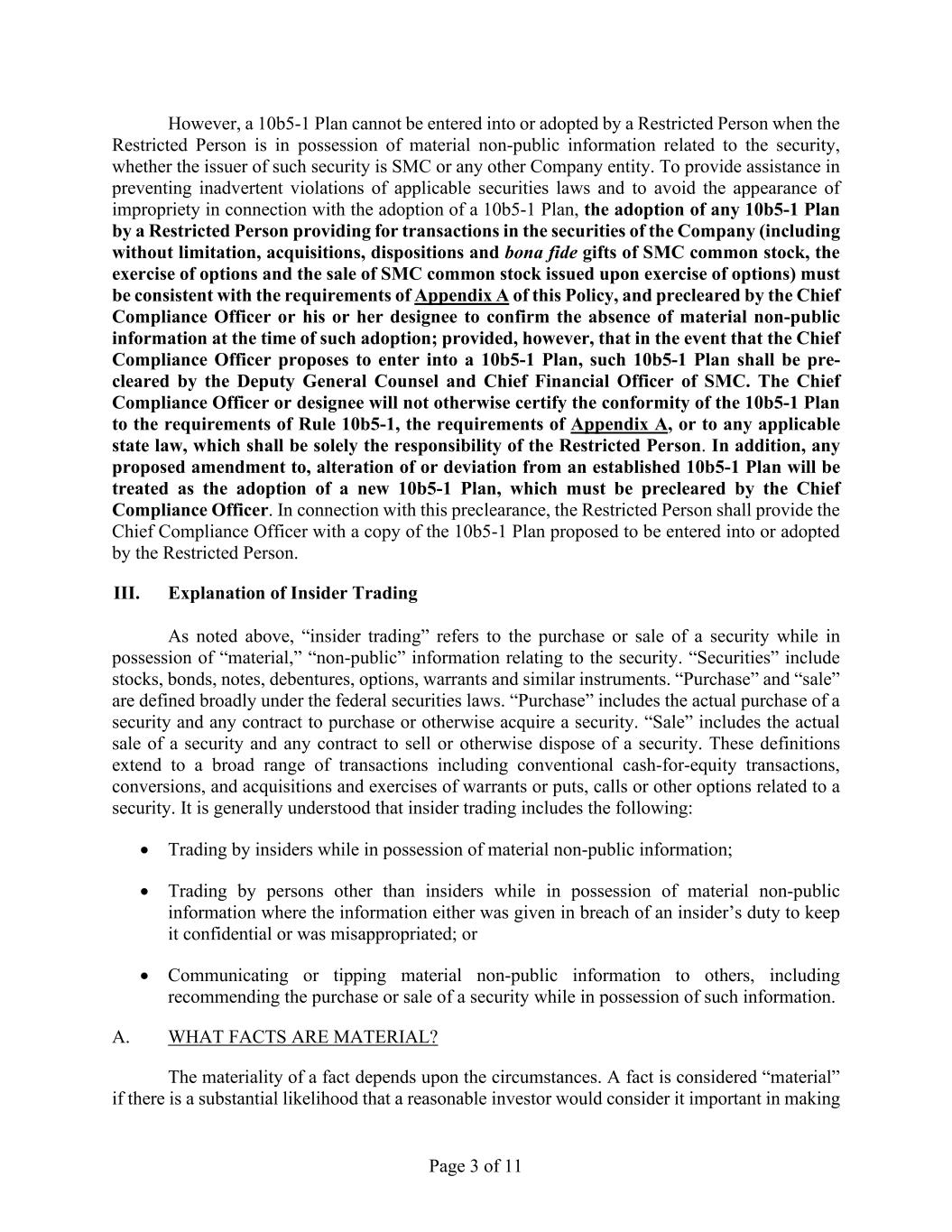
Page 3 of 11 However, a 10b5-1 Plan cannot be entered into or adopted by a Restricted Person when the Restricted Person is in possession of material non-public information related to the security, whether the issuer of such security is SMC or any other Company entity. To provide assistance in preventing inadvertent violations of applicable securities laws and to avoid the appearance of impropriety in connection with the adoption of a 10b5-1 Plan, the adoption of any 10b5-1 Plan by a Restricted Person providing for transactions in the securities of the Company (including without limitation, acquisitions, dispositions and bona fide gifts of SMC common stock, the exercise of options and the sale of SMC common stock issued upon exercise of options) must be consistent with the requirements of Appendix A of this Policy, and precleared by the Chief Compliance Officer or his or her designee to confirm the absence of material non-public information at the time of such adoption; provided, however, that in the event that the Chief Compliance Officer proposes to enter into a 10b5-1 Plan, such 10b5-1 Plan shall be pre- cleared by the Deputy General Counsel and Chief Financial Officer of SMC. The Chief Compliance Officer or designee will not otherwise certify the conformity of the 10b5-1 Plan to the requirements of Rule 10b5-1, the requirements of Appendix A, or to any applicable state law, which shall be solely the responsibility of the Restricted Person. In addition, any proposed amendment to, alteration of or deviation from an established 10b5-1 Plan will be treated as the adoption of a new 10b5-1 Plan, which must be precleared by the Chief Compliance Officer. In connection with this preclearance, the Restricted Person shall provide the Chief Compliance Officer with a copy of the 10b5-1 Plan proposed to be entered into or adopted by the Restricted Person. III. Explanation of Insider Trading As noted above, “insider trading” refers to the purchase or sale of a security while in possession of “material,” “non-public” information relating to the security. “Securities” include stocks, bonds, notes, debentures, options, warrants and similar instruments. “Purchase” and “sale” are defined broadly under the federal securities laws. “Purchase” includes the actual purchase of a security and any contract to purchase or otherwise acquire a security. “Sale” includes the actual sale of a security and any contract to sell or otherwise dispose of a security. These definitions extend to a broad range of transactions including conventional cash-for-equity transactions, conversions, and acquisitions and exercises of warrants or puts, calls or other options related to a security. It is generally understood that insider trading includes the following: • Trading by insiders while in possession of material non-public information; • Trading by persons other than insiders while in possession of material non-public information where the information either was given in breach of an insider’s duty to keep it confidential or was misappropriated; or • Communicating or tipping material non-public information to others, including recommending the purchase or sale of a security while in possession of such information. A. WHAT FACTS ARE MATERIAL? The materiality of a fact depends upon the circumstances. A fact is considered “material” if there is a substantial likelihood that a reasonable investor would consider it important in making
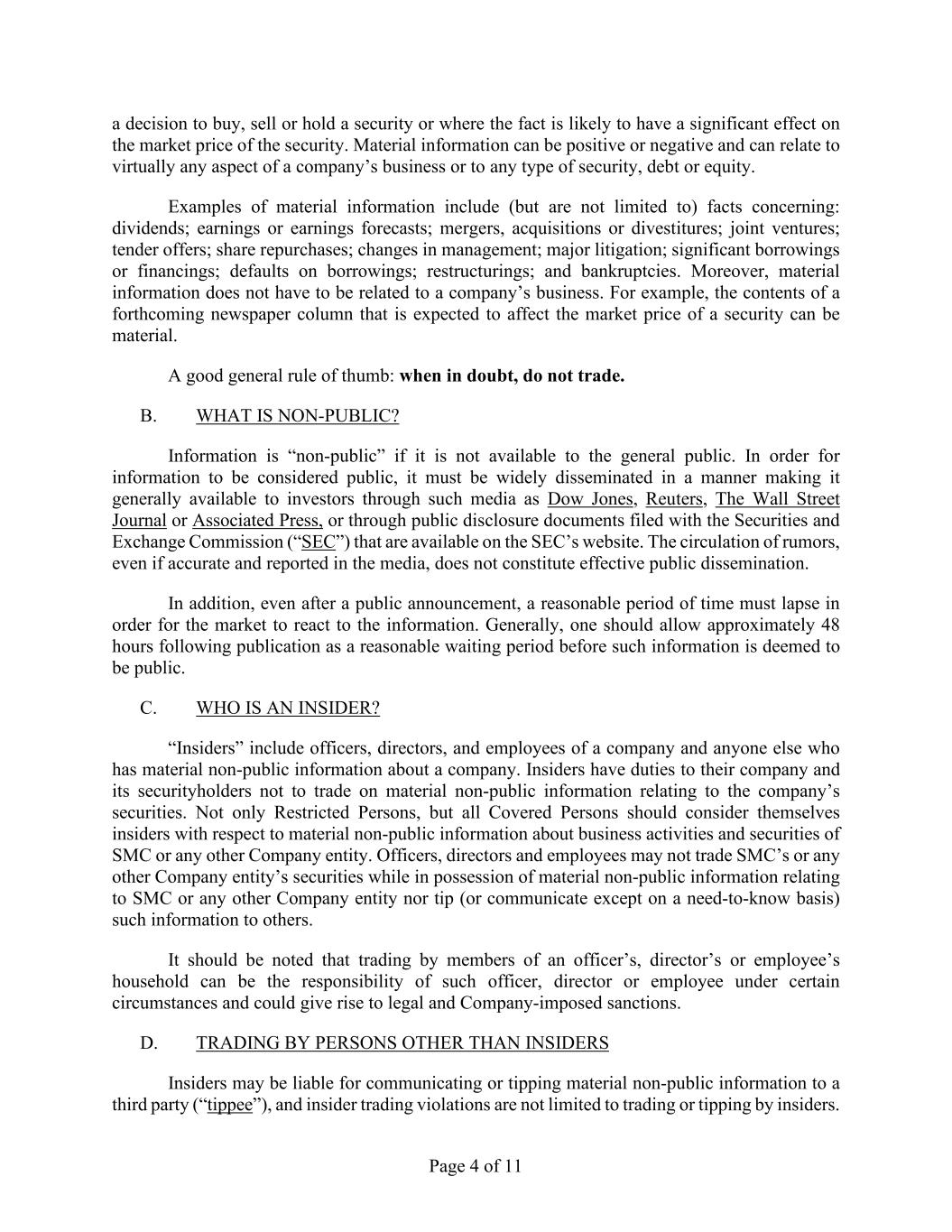
Page 4 of 11 a decision to buy, sell or hold a security or where the fact is likely to have a significant effect on the market price of the security. Material information can be positive or negative and can relate to virtually any aspect of a company’s business or to any type of security, debt or equity. Examples of material information include (but are not limited to) facts concerning: dividends; earnings or earnings forecasts; mergers, acquisitions or divestitures; joint ventures; tender offers; share repurchases; changes in management; major litigation; significant borrowings or financings; defaults on borrowings; restructurings; and bankruptcies. Moreover, material information does not have to be related to a company’s business. For example, the contents of a forthcoming newspaper column that is expected to affect the market price of a security can be material. A good general rule of thumb: when in doubt, do not trade. B. WHAT IS NON-PUBLIC? Information is “non-public” if it is not available to the general public. In order for information to be considered public, it must be widely disseminated in a manner making it generally available to investors through such media as Dow Jones, Reuters, The Wall Street Journal or Associated Press, or through public disclosure documents filed with the Securities and Exchange Commission (“SEC”) that are available on the SEC’s website. The circulation of rumors, even if accurate and reported in the media, does not constitute effective public dissemination. In addition, even after a public announcement, a reasonable period of time must lapse in order for the market to react to the information. Generally, one should allow approximately 48 hours following publication as a reasonable waiting period before such information is deemed to be public. C. WHO IS AN INSIDER? “Insiders” include officers, directors, and employees of a company and anyone else who has material non-public information about a company. Insiders have duties to their company and its securityholders not to trade on material non-public information relating to the company’s securities. Not only Restricted Persons, but all Covered Persons should consider themselves insiders with respect to material non-public information about business activities and securities of SMC or any other Company entity. Officers, directors and employees may not trade SMC’s or any other Company entity’s securities while in possession of material non-public information relating to SMC or any other Company entity nor tip (or communicate except on a need-to-know basis) such information to others. It should be noted that trading by members of an officer’s, director’s or employee’s household can be the responsibility of such officer, director or employee under certain circumstances and could give rise to legal and Company-imposed sanctions. D. TRADING BY PERSONS OTHER THAN INSIDERS Insiders may be liable for communicating or tipping material non-public information to a third party (“tippee”), and insider trading violations are not limited to trading or tipping by insiders.
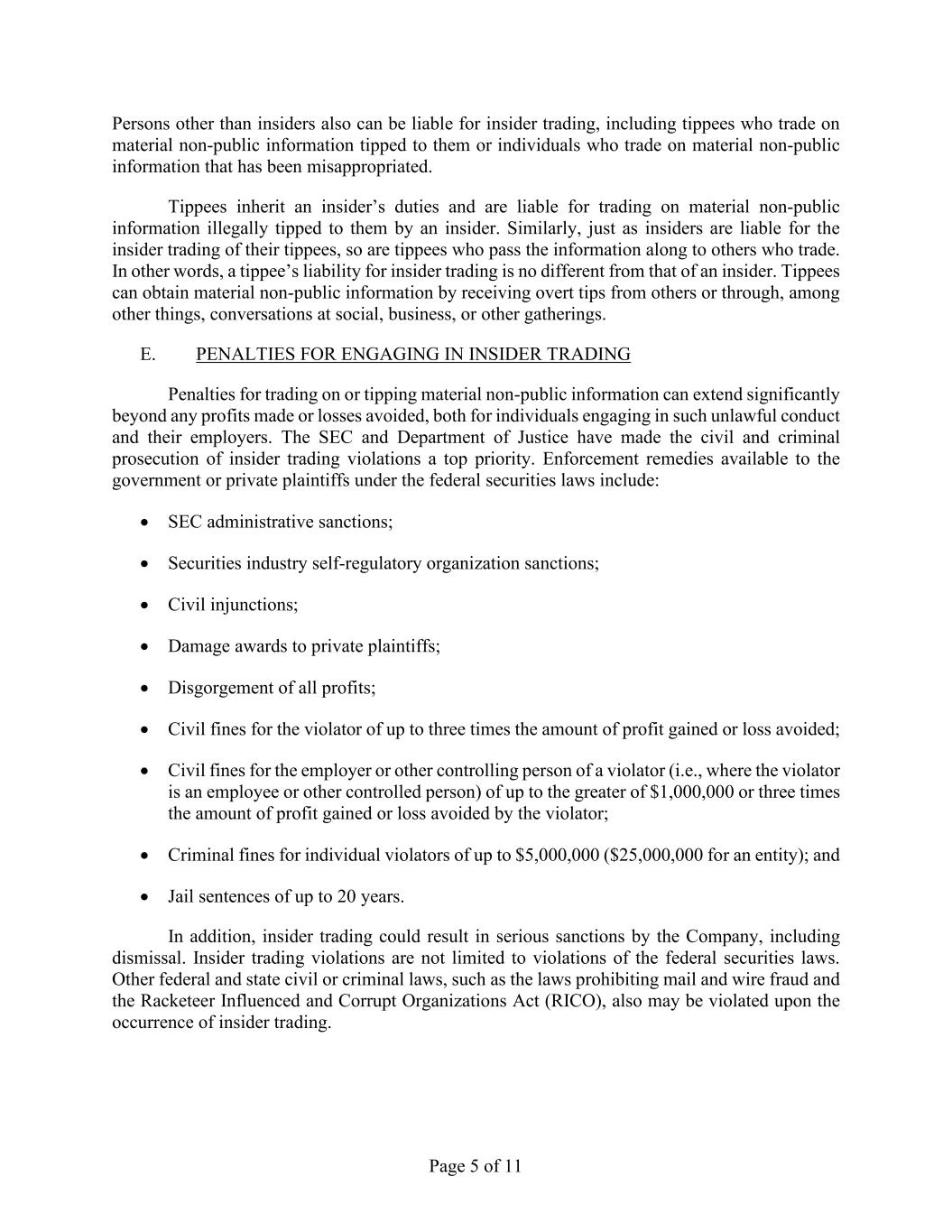
Page 5 of 11 Persons other than insiders also can be liable for insider trading, including tippees who trade on material non-public information tipped to them or individuals who trade on material non-public information that has been misappropriated. Tippees inherit an insider’s duties and are liable for trading on material non-public information illegally tipped to them by an insider. Similarly, just as insiders are liable for the insider trading of their tippees, so are tippees who pass the information along to others who trade. In other words, a tippee’s liability for insider trading is no different from that of an insider. Tippees can obtain material non-public information by receiving overt tips from others or through, among other things, conversations at social, business, or other gatherings. E. PENALTIES FOR ENGAGING IN INSIDER TRADING Penalties for trading on or tipping material non-public information can extend significantly beyond any profits made or losses avoided, both for individuals engaging in such unlawful conduct and their employers. The SEC and Department of Justice have made the civil and criminal prosecution of insider trading violations a top priority. Enforcement remedies available to the government or private plaintiffs under the federal securities laws include: • SEC administrative sanctions; • Securities industry self-regulatory organization sanctions; • Civil injunctions; • Damage awards to private plaintiffs; • Disgorgement of all profits; • Civil fines for the violator of up to three times the amount of profit gained or loss avoided; • Civil fines for the employer or other controlling person of a violator (i.e., where the violator is an employee or other controlled person) of up to the greater of $1,000,000 or three times the amount of profit gained or loss avoided by the violator; • Criminal fines for individual violators of up to $5,000,000 ($25,000,000 for an entity); and • Jail sentences of up to 20 years. In addition, insider trading could result in serious sanctions by the Company, including dismissal. Insider trading violations are not limited to violations of the federal securities laws. Other federal and state civil or criminal laws, such as the laws prohibiting mail and wire fraud and the Racketeer Influenced and Corrupt Organizations Act (RICO), also may be violated upon the occurrence of insider trading.
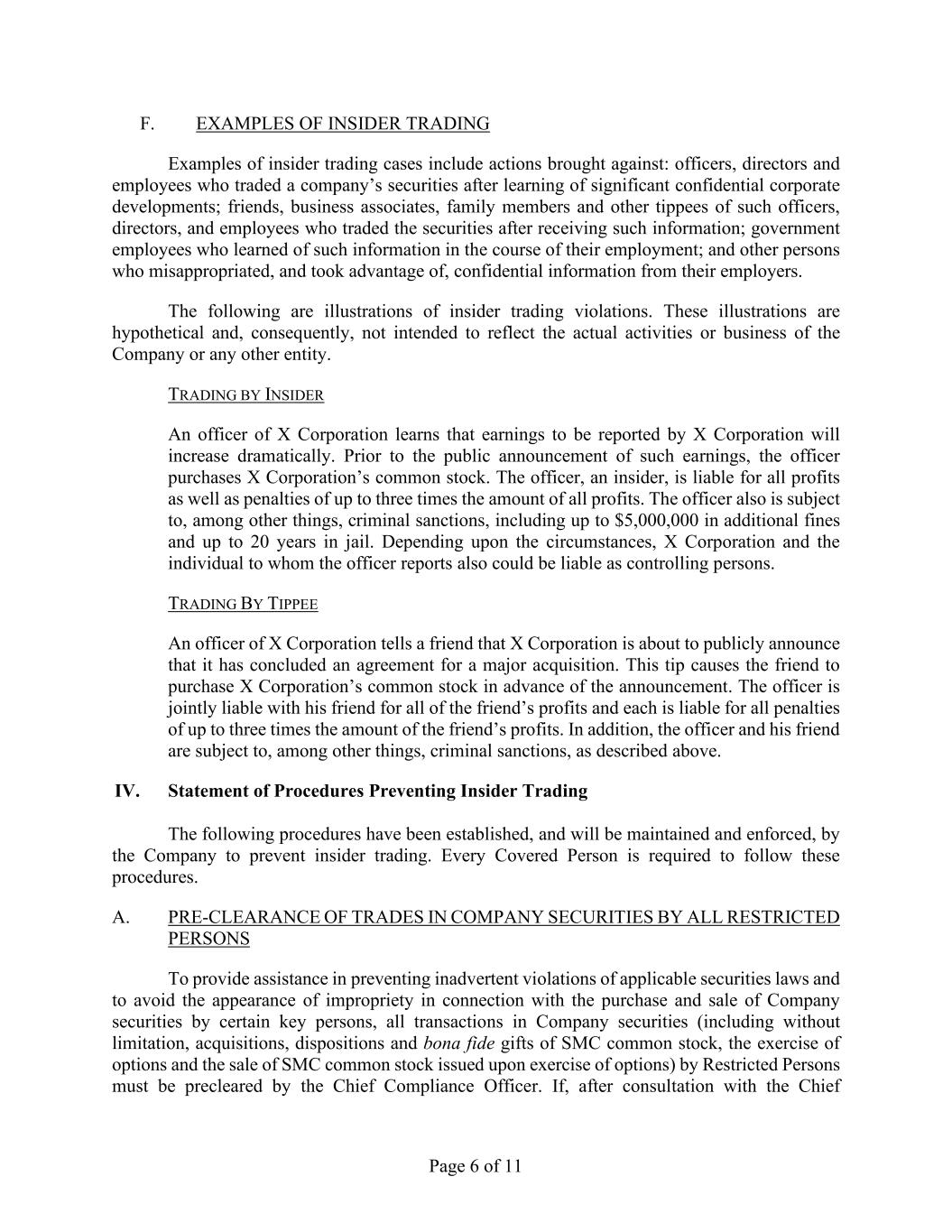
Page 6 of 11 F. EXAMPLES OF INSIDER TRADING Examples of insider trading cases include actions brought against: officers, directors and employees who traded a company’s securities after learning of significant confidential corporate developments; friends, business associates, family members and other tippees of such officers, directors, and employees who traded the securities after receiving such information; government employees who learned of such information in the course of their employment; and other persons who misappropriated, and took advantage of, confidential information from their employers. The following are illustrations of insider trading violations. These illustrations are hypothetical and, consequently, not intended to reflect the actual activities or business of the Company or any other entity. TRADING BY INSIDER An officer of X Corporation learns that earnings to be reported by X Corporation will increase dramatically. Prior to the public announcement of such earnings, the officer purchases X Corporation’s common stock. The officer, an insider, is liable for all profits as well as penalties of up to three times the amount of all profits. The officer also is subject to, among other things, criminal sanctions, including up to $5,000,000 in additional fines and up to 20 years in jail. Depending upon the circumstances, X Corporation and the individual to whom the officer reports also could be liable as controlling persons. TRADING BY TIPPEE An officer of X Corporation tells a friend that X Corporation is about to publicly announce that it has concluded an agreement for a major acquisition. This tip causes the friend to purchase X Corporation’s common stock in advance of the announcement. The officer is jointly liable with his friend for all of the friend’s profits and each is liable for all penalties of up to three times the amount of the friend’s profits. In addition, the officer and his friend are subject to, among other things, criminal sanctions, as described above. IV. Statement of Procedures Preventing Insider Trading The following procedures have been established, and will be maintained and enforced, by the Company to prevent insider trading. Every Covered Person is required to follow these procedures. A. PRE-CLEARANCE OF TRADES IN COMPANY SECURITIES BY ALL RESTRICTED PERSONS To provide assistance in preventing inadvertent violations of applicable securities laws and to avoid the appearance of impropriety in connection with the purchase and sale of Company securities by certain key persons, all transactions in Company securities (including without limitation, acquisitions, dispositions and bona fide gifts of SMC common stock, the exercise of options and the sale of SMC common stock issued upon exercise of options) by Restricted Persons must be precleared by the Chief Compliance Officer. If, after consultation with the Chief
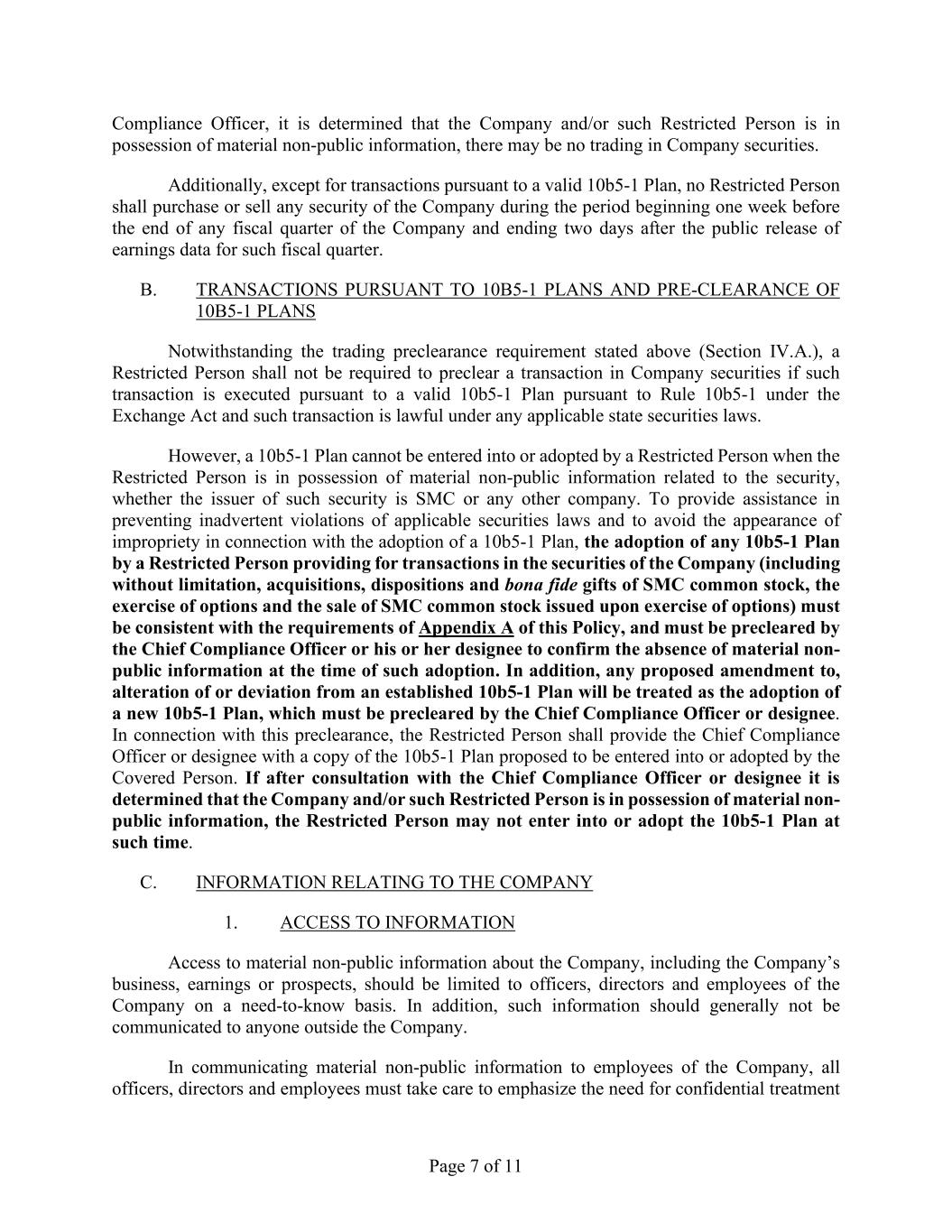
Page 7 of 11 Compliance Officer, it is determined that the Company and/or such Restricted Person is in possession of material non-public information, there may be no trading in Company securities. Additionally, except for transactions pursuant to a valid 10b5-1 Plan, no Restricted Person shall purchase or sell any security of the Company during the period beginning one week before the end of any fiscal quarter of the Company and ending two days after the public release of earnings data for such fiscal quarter. B. TRANSACTIONS PURSUANT TO 10B5-1 PLANS AND PRE-CLEARANCE OF 10B5-1 PLANS Notwithstanding the trading preclearance requirement stated above (Section IV.A.), a Restricted Person shall not be required to preclear a transaction in Company securities if such transaction is executed pursuant to a valid 10b5-1 Plan pursuant to Rule 10b5-1 under the Exchange Act and such transaction is lawful under any applicable state securities laws. However, a 10b5-1 Plan cannot be entered into or adopted by a Restricted Person when the Restricted Person is in possession of material non-public information related to the security, whether the issuer of such security is SMC or any other company. To provide assistance in preventing inadvertent violations of applicable securities laws and to avoid the appearance of impropriety in connection with the adoption of a 10b5-1 Plan, the adoption of any 10b5-1 Plan by a Restricted Person providing for transactions in the securities of the Company (including without limitation, acquisitions, dispositions and bona fide gifts of SMC common stock, the exercise of options and the sale of SMC common stock issued upon exercise of options) must be consistent with the requirements of Appendix A of this Policy, and must be precleared by the Chief Compliance Officer or his or her designee to confirm the absence of material non- public information at the time of such adoption. In addition, any proposed amendment to, alteration of or deviation from an established 10b5-1 Plan will be treated as the adoption of a new 10b5-1 Plan, which must be precleared by the Chief Compliance Officer or designee. In connection with this preclearance, the Restricted Person shall provide the Chief Compliance Officer or designee with a copy of the 10b5-1 Plan proposed to be entered into or adopted by the Covered Person. If after consultation with the Chief Compliance Officer or designee it is determined that the Company and/or such Restricted Person is in possession of material non- public information, the Restricted Person may not enter into or adopt the 10b5-1 Plan at such time. C. INFORMATION RELATING TO THE COMPANY 1. ACCESS TO INFORMATION Access to material non-public information about the Company, including the Company’s business, earnings or prospects, should be limited to officers, directors and employees of the Company on a need-to-know basis. In addition, such information should generally not be communicated to anyone outside the Company. In communicating material non-public information to employees of the Company, all officers, directors and employees must take care to emphasize the need for confidential treatment

Page 8 of 11 of such information and adherence to the Company’s policies with regard to confidential information. 2. INQUIRIES FROM THIRD PARTIES Inquiries from third parties, such as industry analysts or members of the media, about the Company should be directed to the Chief Financial Officer of SMC. D. LIMITATIONS ON ACCESS TO THE COMPANY’S INFORMATION The following procedures are designed to maintain confidentiality with respect to the Company’s business operations and activities. 1. All officers, directors and employees should take all steps and precautions necessary to restrict access to, and secure, material non-public information by, among other things: • Maintaining the confidentiality of Company-related transactions; • Conducting business and social activities so as not to risk inadvertent disclosure of confidential information. Review of confidential documents in public places should be conducted so as to prevent access by unauthorized persons; • Restricting access to documents and files (including computer files) containing material non-public information to individuals on a need-to-know basis (including maintaining control over the distribution of documents and drafts of documents); • Promptly removing and cleaning up all confidential documents and other materials from conference rooms following the conclusion of any meetings; • Disposing of all confidential documents and other papers, after there is no longer any business or other legally required need, through shredders when appropriate; • Restricting access to areas likely to contain confidential documents or material non-public information; and • Avoiding the discussion of material non-public information in places where the information could be overheard by others such as in elevators, restrooms, hallways, restaurants, airplanes or taxicabs. 2. Personnel involved with material non-public information, to the extent feasible, should conduct their business and activities in areas separate from other Company activities.

Page 9 of 11 E. AVOIDANCE OF CERTAIN AGGRESSIVE OR SPECULATIVE TRADING Covered Persons and their respective family members (including spouses, minor children, or any other family members living in the same household) should ordinarily not directly or indirectly participate in transactions involving trading activities which by their aggressive or speculative nature may give rise to an appearance of impropriety. Such activities would include the purchase of put or call options, or the writing of such options. F. EXECUTION AND RETURN OF ACKNOWLEDGMENT After reading this policy statement all Covered Persons shall provide such acknowledgment as directed by the Chief Compliance Officer or his or her designee.

Appendix A APPENDIX A Rule 10b5-1 Trading Plans Rule 10b5-1 under the Exchange Act can provide an “affirmative defense” to officers, directors, and other individuals to insider trading allegations for transactions under a previously established contract, plan, or instruction. This rule presents an opportunity for insiders to establish arrangements to sell (or purchase) Company securities without the restrictions imposed by closed trading periods or preclearance procedures - even when material non-public information exists. The arrangements may include blind trusts, other trusts, pre- scheduled stock option exercises and sales, prearranged trading instructions, and other brokerage and third-party arrangements. The rule only provides an “affirmative defense” (which must be proven) if there is an insider trading lawsuit. It does not prevent anyone from bringing a lawsuit, nor does it prevent the media from writing about the sales. As noted below, trades completed pursuant to a Rule 10b5-1 trading arrangement must also comply with applicable federal and state securities laws including, without limitation, the requirements that (i) all sales must be registered with the SEC or fall into exemption from registration (such as Rule 144); and (ii) if applicable, a Form 4 is filed with the SEC within two business days of the purchase or sale by insiders subject to Section 16 under the Exchange Act. The program must be documented, bona fide, and previously established (at a time when the insider did not possess material non-public information) and must specify the price, amount, and date of trades or provide a formula or mechanism to be followed. In order to reduce the risk of litigation and adverse press, and to preserve our reputation, if you would like to use such a trading program: • The Chief Compliance Officer or his or her designee must pre-approve your program (which would include any plan, arrangement, or trading instructions relating to our securities, such as blind trusts, discretionary accounts with banks or brokers, limit orders, hedging strategies, and other arrangements) prior to entry into or modification of the plan; • The plan must comply with the SEC’s “cooling-off” periods: o In the case of directors and any officer required to file reports under Section 16 of the 1934 Act, trading under the plan must not begin until the later of (1) 90 days following plan adoption or modification; and (2) two business days following disclosure of SMC’s financial results for the fiscal quarter (by Form 10-K or Form 10-Q) in which the plan was adopted or modified (but not to exceed 120 days following plan adoption or modification) o In the case of any other employee, at least 30 days must elapse before the first transactions may occur under the plan following adoption or modification; • you may not establish, modify or terminate the program when you possess material non- public information; • if a 10b5-1 plan is terminated, you must wait at least 14 calendar days before trading outside of the plan; and
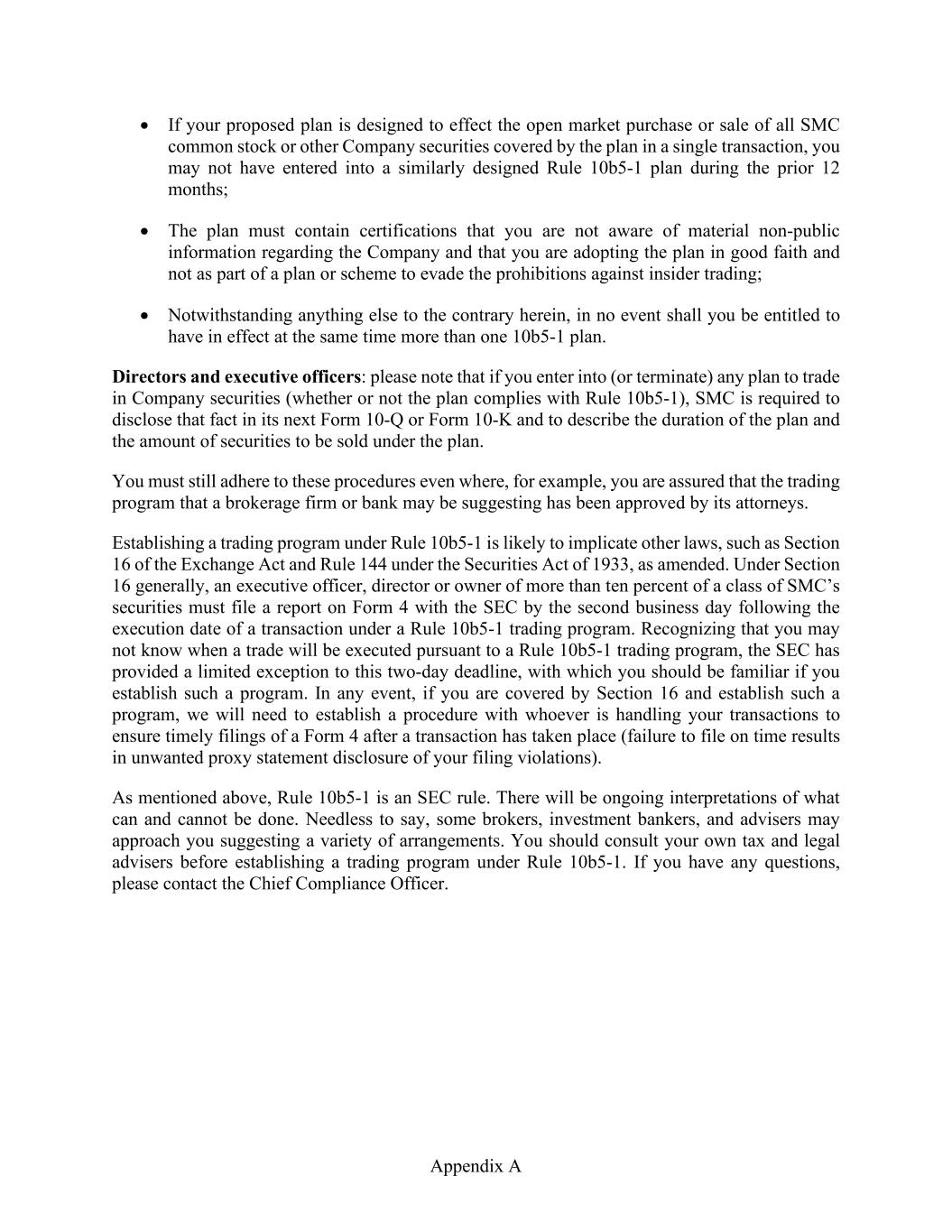
Appendix A • If your proposed plan is designed to effect the open market purchase or sale of all SMC common stock or other Company securities covered by the plan in a single transaction, you may not have entered into a similarly designed Rule 10b5-1 plan during the prior 12 months; • The plan must contain certifications that you are not aware of material non-public information regarding the Company and that you are adopting the plan in good faith and not as part of a plan or scheme to evade the prohibitions against insider trading; • Notwithstanding anything else to the contrary herein, in no event shall you be entitled to have in effect at the same time more than one 10b5-1 plan. Directors and executive officers: please note that if you enter into (or terminate) any plan to trade in Company securities (whether or not the plan complies with Rule 10b5-1), SMC is required to disclose that fact in its next Form 10-Q or Form 10-K and to describe the duration of the plan and the amount of securities to be sold under the plan. You must still adhere to these procedures even where, for example, you are assured that the trading program that a brokerage firm or bank may be suggesting has been approved by its attorneys. Establishing a trading program under Rule 10b5-1 is likely to implicate other laws, such as Section 16 of the Exchange Act and Rule 144 under the Securities Act of 1933, as amended. Under Section 16 generally, an executive officer, director or owner of more than ten percent of a class of SMC’s securities must file a report on Form 4 with the SEC by the second business day following the execution date of a transaction under a Rule 10b5-1 trading program. Recognizing that you may not know when a trade will be executed pursuant to a Rule 10b5-1 trading program, the SEC has provided a limited exception to this two-day deadline, with which you should be familiar if you establish such a program. In any event, if you are covered by Section 16 and establish such a program, we will need to establish a procedure with whoever is handling your transactions to ensure timely filings of a Form 4 after a transaction has taken place (failure to file on time results in unwanted proxy statement disclosure of your filing violations). As mentioned above, Rule 10b5-1 is an SEC rule. There will be ongoing interpretations of what can and cannot be done. Needless to say, some brokers, investment bankers, and advisers may approach you suggesting a variety of arrangements. You should consult your own tax and legal advisers before establishing a trading program under Rule 10b5-1. If you have any questions, please contact the Chief Compliance Officer.